Saves Oil
-
- Marine Lubricants: New Year, New Emission Rules Maritime Reporter, Dec 2014 #62
January 1, 2015 is an important date for ship owner and operators to ensure that their vessels, when operating inside ECA zones, are doing so in compliance with strict new emission edicts concerning the emission of sulfur. While the effects of low-sulfur fuel on marine engines is well recorded, on the eve of this new legislation we rounded up four executives from marine lubricant companies –
• Stefan Claußen, LUKOIL Marine Lubricants
• Gianluca Marucci, Castrol
• Jan Toschka, GM, Shell Marine Products, and
• Rik Truijens, Chevron Marine Lubricants
– to discuss some of the technical and logistical matters you must consider.
The move to low sulfur fuels is well recorded, but from your point of view, describe the situation that ship owners face regarding fuel selection and cylinder lubrication come January 1, 2015?
• Marucci, Castrol In general, there are three potential compliance options for vessels operating in ECAs in the short to medium term: the use of scrubbing technologies, converting to use of liquefied natural gas (LNG) or burning 0.1% sulfur fuel. There has been some uptake of scrubbers but to date this has been limited to operators of ships sailing predominantly in ECAs such as ferries and cruise ships due to the high costs of retrofitting vessels. LNG ticks the box in terms of emissions requirements but the distribution infrastructure is still in the early stages of development. Therefore, we envisage that from 2015, using 0.1% sulfur fuel will be the most practical option.
To maximize operational performance, prevent downtime and limit engine wear, operators need to proactively address fuel and lubrication changes in tandem. In particular, commonly used higher BN products such as 70BN and 100BN may compromise engine performance if used with 0.1% sulfur fuel on a prolonged basis. This is because BN refers to alkalinity and as sulfur is acidic, the less acidity there is, the lower the level of alkalinity that is required in a lubricant. Yet, with crews stretched and skills gaps on-board, the temptation to stay with an existing lubricant could be high. This is why lubricant manufacturers need to be hands-on in helping operators and their crews to manage the transition to a lower BN lubricant. Our recommendation for the majority of vessels is a 40BN lubricant with higher levels of dispersancy and detergency additives than in higher BN cylinder oils.. So far, we have been in discussion with many operators and they have already started training their crew to meet the challenges of the fuel change over. We are also working with customers to help crew better understand the implications for lubricant application in these scenarios and how to effectively switch lubricants.
Ultimately, the response to the changes in sulfur regulations in ECAs from 2015 will present a significant learning curve across the industry, spanning operational, financial and legal implications. Within this, lubricant manufacturers will need to work closely with OEMs and operators to gain a deeper understanding of how lubricants are performing with distillates once use becomes widespread. Castrol has been looking at different technologies for use with 0.1% sulfur fuels as well as with LNG, and will be monitoring in-service performance with customers and OEMs from the start of 2015.
Specifically, this reduction in sulfur content has a trickle down impact across the engine. What does the change specifically mean for marine engines? For their cylinder lubricant?
• Truijens, Chevron Marine Lubricants With the majority of operators clearly appearing to opt for operation on low sulfur distillate fuels, there is an opportunity to improve performance through the use of lubricants specifically optimized for the lower acidity of the new, cleaner and more environmentally friendly fuel. With no scrubber installed the maximum sulfur content of the fuel burned while sailing in ECAs will be capped at 0.1%wt. At this relatively low sulfur content, the amount of acids generated during the combustion process is relatively low. Since the risk of acids condensing on the cylinder liners becomes low accordingly, there is less need for alkalinity (base, BN) in the cylinder oil to neutralize acids. At this point the main task for the cylinder oil is to provide lubrication and keep the components in the combustion chamber clean, rather than prevent from corrosion occurring. And this is exactly what our latest cylinder oil development, Taro Special HT LF, was designed for.
• Toschka, Shell On a positive note, most low-speed 2 stroke engines will be able to burn fuels with a much lower sulfur content without needing significant modifications. However, it is important that the right choice of cylinder oil is made. Guidance from the OEMs has been clear in that they expect vessels to switch to a cylinder oil with a lower BN (<40) at the same time as when the customers switch to the very low sulfur fuel. Sustained running on a high BN lubricant with very low sulfur fuel can result in the formation of abrasive deposits on piston top lands, piston rings, piston ring grooves and ring lands. These deposits can disrupt the lubricant film, ultimately resulting in scuffing and cylinder liner damage.
• Marucci, Castrol The prolonged use of a high-BN lubricant of around 70BN or 100BN in a low sulphur environment can produce excessive deposit formation throughout the hot parts of the engine. One area of concern is ash deposition on the crown land which can impact the oil film, and, combined with the lack of controlled corrosion, the liner surface becomes smooth and polished and so unable to hold a stable oil film. If the condition continues, scuffing and total destruction of the liner surface can occur due to metal-to-metal contact.
Frankly, there seems to be plenty of confusion in the market today regarding fuel and lube choices. Please discuss your company’s investment & efforts in this regard, specifically discussing the rationale behind the solution you offer.
• Claußen, LUKOIL Our aim is to help the operator to manage lubrication of two stroke engines. To this end we have developed iCOlube, an intelligent Cylinder Oil lubrication unit designed to use fresh or used system oil to optimize NAVIGO 100 MCL. The unit tailors the alkalinity reserve of the cylinder oil to the prevailing engine load and fuel sulfur content with the advantage that only one grade of cylinder oil is necessary on board, the engine always stays at its optimum feed rate and the operator only needs to enter the sulfur content of the fuel. With this innovative approach we offer our customers the following benefits: Easy and time-saving operation; Fuel savings; Maintaining the engine in best condition; Reduced oil costs; Environmentally friendly technology; and, Easy installation.
• Toschka, Shell Shell continues to maintain a close collaboration with key industry players, in particular the OEMs; to ensure that we provide solutions that meet the needs of both current and future engines. Specifically, we have chosen to develop a lower BN (BN=25) cylinder oil that has been designed to work with the types of low sulfur fuels that we anticipate being available for customers to meet the ECA requirements from January 1, 2015. In line with the OEM guidance, we believe that this is necessary to ensure continued safe and reliable operation of modern low speed, 2 stroke engines.
What is the biggest challenge for you, as a lubricant manufacturer, to stay ahead of these new regulations and technical demand?
• Claußen, LUKOIL To do performance tests of new cylinder oils in real engine after development work while no customer is running the two stroke engine on distillate or gas yet really.
• Toschka, Shell The shipping industry is facing a significant growth challenge leading to the industry adopting various cost savings measures such as slow-steaming, a drive for fuel efficiencies and low cost operations. The changes in the legislation only compounds the complexities and challenges for Shell as we try and build collaboration with the industry players from the legislators, OEMs to ship owners/operators.
• Truijens, Chevron Marine Lubricants The new ECA regulations make the choice for fuel and lubes more critical than ever. As a dedicated supplier to the global shipping industry Chevron Marine Lubricants has invested heavily in the development of appropriate new technology for our lubes. We realized early on that simply reformulating our existing products would not be sufficient – we needed to start again from scratch. We had the enormous benefit of access to a tanker fleet operating in the already tightly regulated Californian waters so have been able to gain extensive proof of performance for our new products in real world sea conditions. Those products are now available globally.
• Marucci, Castrol In terms of compliance with the 2015 ECA requirements specifically, the main challenge is that marine gas oil (MGO) has not been widely used so far. 2015 will be a big learning curve for everyone in the industry. Within this, lubricant manufacturers will need to work closely with OEMs and operators to gain a deeper understanding on how lubricants are performing with distillates once use becomes more widespread. Castrol has been looking at different technologies for use with 0.1% sulphur fuel and LNG for some time and we will be further monitoring in-service performance with customers and OEMs during 2015. In relation to this, we will also have a clearer idea of market demand.
Once the regulations are implemented, we will be better positioned to build a more accurate understanding of just how many vessels are operating in ECAs for a significant period of time and of those, how many will persist with 0.1% low sulphur fuel as an ongoing solution or will look to explore alternative options for reducing sulphur emissions such as use of LNG or abatement technology, such as scrubbing.
More broadly, both regulation and vessel operating conditions are continuously evolving and our challenge is to anticipate future trends and use this to shape the ongoing development of our services and products. This helps us to advise our customers and enable them to manage change pro-actively. The next major change is a planned global cap of 0.5% sulphur in 2020 which will mean further changes to cylinder oils.
What are the problems a ship owner / operator might expect should they make the wrong choice of cylinder lubricant?
• Claußen, LUKOIL Running long term on the wrong lubricant, e.g. high BN cylinder oil while burning low sulfur fuel or distillate fuel, can increase the level of deposits. The lube oil/unused additives are contributing to the deposits and higher levels of deposits can lead to higher wear rates on ring and/or liner and ring breakages.
• Toschka, Shell The choice of the right cylinder oil is crucial in ensuring the engine performs to its intended purpose, delivers efficiencies and maintains reliability. The wrong choice of lubricant could significantly impact the engine potentially resulting in cold corrosion and/or deposits build-up ultimately impacting the performance of the engine and leading to hardware damages.
Put in perspective if you will, how the reduced emissions drive in maritime has impacted the overall business of your company. Is this revolutionary and unique, or is this simply an extension of similar challenges faced in other transport modes years ago?
• Claußen, LUKOIL The increased focus on environmental issues and emission reduction has an impact, of course. If regulations regarding the fuel sulfur content change, lubricants have to be developed which match the new fuel qualities. Furthermore, the general awareness of customers for environmental issues has risen and we see growing demand for environmentally friendly solutions such as iCOlube, whose environmental impact has been studied in a Life Cycle Assessment (LCA): Not only does it allow for easy engine operation, oil savings and improved engine maintenance, but can also reduce fuel consumption by up to 1% and enables a 13% reduction of CO2 equivalent compared to conventional ship operation. By way of comparison, over one year a fleet of 12,500 ships will save more than 525,000 tons of CO2 equivalent, which is equivalent of taking 225,000 passenger cars of the road.
• Marucci, Castrol The focus on emissions reduction has influenced our offering as it is essential that we provide a high performing lubricant and specialized support services to ensure that our customers use the right lubricant with low sulfur fuels. It is also critical that we help them to plan for this transition. The 2015 ECA regulation changes are a major milestone but further reductions to SOx, NOx and particulate matter will continue to drive change, including the types of fuels that will be used to meet increasingly stringent targets. Additionally, the focus on CO2 emissions reduction is also driving the development of more fuel efficient engines. A direct result of this has been the need for high BN oils to combat corrosion. We therefore need to help customers manage the complexity of using different lube oil types to cover the wide range of demands from today’s operational environment.
This means that we can never stand still and need to continue looking forward and innovating so that we can meet customers’ future requirements. While other transportation sectors have faced similar challenges in the past, the shipping industry has its own unique set of considerations. Undoubtedly, this is a significant period of change as improving environmental performance is set within the context of a broader commercial context. Optimizing efficiencies, achieving cost-reductions and improving overall profitability are absolute priorities for the industry at present. At the same time, the 2015 European and North American 0.1% sulfur caps as well as other medium-term emissions legislation, pose further operational and financial considerations. Simultaneously, ship operators still face shortages of skilled crews that are on the front-line for managing and implementing some of these day-to-day changes on board vessels. This highlights the complexity of the issue. However, shipping has proven itself to be a robust and adaptable industry throughout history. I am confident, that with the right support, the industry will rise to the challenge.
Put in perspective the increased cost of these new solutions for cylinder lubricant. How much more is a “typical” ship owner paying in 2015 vs. a few years ago, looking at the same ship and route?
• Claußen, LUKOIL To put a number on it, we need more experience with iCOlube in the low BN range and running on destillate fuel. However, the iCOlube helps to maintain or even reduces the cost of lubrication, reduces wear and can reduce fuel cost up to 1%. The optimization of 100 BN cylinder oil with fresh or used system oil saves oil and costs as well and further savings will derive from wear reduction (e.g. less spare parts).
• Marucci, Castrol We can’t comment on our pricing but according to Moore Stephens’ Future Operating Costs Survey 2014 which was issued in October, ship owners and operators expenditure on lubricants is expected to rise by between 1.7% in 2014 and 2% in 2014, depending on the sector. For many operators any higher cost associated with newer cylinder oils has been more than compensated for by slow steaming which has reduced consumption significantly.
• Toschka, Shell There is no doubt that the reduced emissions drive in the marine industry has increased complexity for both our customers and us. From our perspective, we have needed to develop and maintain multiple products to meet all the different customer requirements, In addition, we see an increased need for technical support – be that in offering used oil analysis programs, helping to interpret and implement OEM requirements, cylinder condition monitoring or in assisting in crew development.
Right now, what do you see as the biggest mistake a ship owner / operator could make in moving forward with their marine fuel and lube choice?
• Truijens, Chevron Marine Lubricants Choosing the wrong combination of lube and fuel exposes shipping operators to the risk of excess engine wear – and this applies both inside and outside the ECAs. Choosing a lube with excess BN or alkalinity in combination with low sulfur fuel can result in in-cylinder deposits leading in turn to scuffing problems and thus excess wear. The application of a cylinder oil with excess alkalinity (BN) in combination with low sulfur fuel can result in excessive deposit formation on pistons, fouling of the scavenge space and exhaust tract and can lead to excessive wear and even scuffing if maintained for prolonged period of time.
Go the other way and choose a low BN product with typical bunkered fuel (which may have up to 3.5% sulfur compared with the just 0.1% allowed in ECA areas) then excess acidity can lead to accelerated corrosion and engine component wear.
The secret is getting the alkalinity/acidity balance in the combustion chamber right. Our new 100 BN oil, introduced earlier this year, aims to produce the optimum balance in the new generation of engines operating at ultra low rpm speeds.
We work in partnership with our ship operating customers to ensure the right balance and lube dosing levels whatever the conditions. We stress the value of incorporating a cylinder drip oil analysis program to continually monitor iron wear levels in this regard. Particularly, a drip oil program that measures both magnetic and corrosive iron. Our long term drip oil analysis program – conducted on board and on shore – has more than seven years of history and is a proven, OEM-endorsed tool to oversee that critical balance.
Mobilgard 525New cylinder oil for two stroke slow speed engines to facilitate compliance with the 0.1% sulfur fuel in the ECAs.
At SMM in Hamburg ExxonMobil launched Mobilgard 525, a cylinder oil with a 25 Base Number (BN) that is specifically engineered for used with fuel containing 0.1% sulfur, and approved by MAN and Wärtsilä for use in two stroke engines.
“This will enable the two stoke slow speed engines to run effectively on low sulfur fuel, as the cylinder lubes available currently, the BN level is simply too high,” said Iain White, Global Field Marketing Manager, ExxonMobil Marine Fuels & Lubricants.
Ships entering Emission Control Areas (ECAs) after January 1, 2015 must use fuel with a maximum 0.1% sulfur content. Though the transition has been widely publicized globally, there remains confusion and resistance among ship owners. ExxonMobil, with its Mobilgard 525, seeks to ease the transition.
If the BN of your cylinder lubricant is too high, “the hot areas of the piston, which is the piston crown and the top of the sides you get deposit build up if the BN is too high in conjunction with the low sulfur fuel, because you’re not using that additive for neutralization purposes … you simply don’t need it. So it plates out on the piston and causes wear,” White explains.
The 25 BN formulation has been engineered using high quality base oils and an advanced ‘balanced formulation’ approach. To put it simply, it’s all a matter of chemistry.
“The challenge is that the chemistry that goes into the product to do all of that neutralization is also the chemistry that (helps to keep the engine clean),” said White. “So as you take that out to reduce the deposits, you have to struggle to keep your engine clean, and your problem moves from the crown lands where you get deposits back to the ring pack where it gets very dirty. We’ve cracked that challenge by balancing the chemistry so that the oil does its job; deposits are minimized and the engine stays clean.”
With an avalanche of new rules regarding emissions from diesel engines coming into force starting now and extending through 2020, the fuel and lube buy and procedure for ship owners promises to get even more convoluted.
“It’s really a complex picture,” said White, noting that the roster of choices includes fuel switch-over in ECA zones, the use of distillates, outfitting ships with scrubbers or incorporating a growing list of alternative fuels, starting with LNG. “From ExxonMobil’s perspective, instead of bringing a new product out and going to the customers to talk about the new product, we first of all go to the customer to talk about their challenge. For example we’ve made an insights film into the cold corrosion issue, because we’re finding that people don’t understand that. We do the training first.”
(As published in the December 2014 edition of Maritime Reporter & Engineering News - http://magazines.marinelink.com/Magazines/MaritimeReporter)
-
 )
March 2024 - Marine Technology Reporter page: 42
)
March 2024 - Marine Technology Reporter page: 42NEW TECH OCEANOLOGY INTERNATIONAL 2024 Image courtesy Greg Trauthwein Image courtesy BIRNS MacArtney launches the new ultra-compact ø12.7 mm SubConn Nano connector. Innovative connectivity built on 45 years of ? eld-proven and market-trusted design. Image courtesy MacArtney Birns celebrated its 70th
-
 )
March 2024 - Marine Technology Reporter page: 39
)
March 2024 - Marine Technology Reporter page: 39Photo courtesy Global Ocean Design Figure 7 A 35Ah AGM lead-acid battery is tested using the West Mountain Radio CBA to show the effect of simply ? lling the battery voids with mineral oil as a compensating ? uid. The CBA is programmed to cut-off at a voltage of 10.50v. The top line (red) shows the
-
 )
March 2024 - Marine Technology Reporter page: 38
)
March 2024 - Marine Technology Reporter page: 38LANDER LAB #10 Photo courtesy West Mountain Radio Photo courtesy of Clarios/AutoBatteries.com Figure 6 The West Mountain Radio Computerized Battery Analyzer (CBA V) attaches to a Figure 5 laptop by a USB-B cable, and to a battery by Powerpole® Connectors. Exploded view of an AGM lead-acid battery.
-
 )
March 2024 - Marine Technology Reporter page: 36
)
March 2024 - Marine Technology Reporter page: 36LANDER LAB #10 Of special interest for marine applications, LiPo batteries are Shipping any kind of lithium battery can be a challenge, and offered in a “pouch” design, with a soft, ? at body. The pouch IATA regs vary with the batteries inside or outside an instru- is vacuum-sealed, with all voids ?
-
 )
March 2024 - Marine Technology Reporter page: 35
)
March 2024 - Marine Technology Reporter page: 35Figure 1 A self-righting vehicle design with buoyancy high and weight low, WHOI’s SeaBED AUV captures the attention of a pair of curious Antarctic penguins as it is deployed from the British research vessel James Clark Ross. Vehicle designers allowed for temperature reduction of battery capacity. Recharge
-
 )
March 2024 - Marine Technology Reporter page: 33
)
March 2024 - Marine Technology Reporter page: 33regulated industry in the world.” How- ever, commercial success depends on many factors, not least a predictable OPEX. Over the past four years, SMD has worked with Oil States Industries to calculate cost per tonne ? gures for prospective customers. Patania II uses jet water pumps to Oil States’
-
 )
March 2024 - Marine Technology Reporter page: 18
)
March 2024 - Marine Technology Reporter page: 18detection with higher above the pipeline and still obtain valuable data. The the measurement of protection levels (potential) using non- increased speed saves costly vessel time, while the larger mea- contact sensors. The collected data is then merged with CP surement distance lowers the risks associated
-
 )
March 2024 - Marine Technology Reporter page: 17
)
March 2024 - Marine Technology Reporter page: 17• Integrity assessment, and otherwise covered, e.g., by rock dump. As for depletion of • Mitigation, intervention and repair. sacri? cial anodes, this can be dif? cult or even impossible to Selecting the best method for collecting the data these work- estimate due to poor visibility, the presence of
-
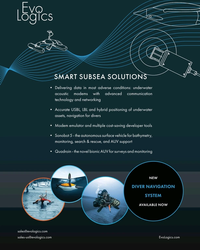 )
March 2024 - Marine Technology Reporter page: 2nd Cover
)
March 2024 - Marine Technology Reporter page: 2nd CoverSMART SUBSEA SOLUTIONS • Delivering data in most adverse conditions: underwater acoustic modems with advanced communication technology and networking • Accurate USBL, LBL and hybrid positioning of underwater assets, navigation for divers • Modem emulator and multiple cost-saving developer tools • Sonobot
-
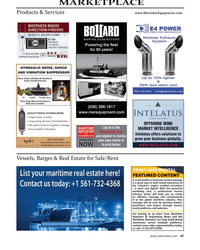 )
April 2024 - Maritime Reporter and Engineering News page: 47
)
April 2024 - Maritime Reporter and Engineering News page: 47MARKETPLACE Products & Services www.MaritimeEquipment.com Powering the fleet for 60 years! HYDRAULIC NOISE, SHOCK AND VIBRATION SUPPRESSOR Noise, Shock, VibraO on & PulsaO on in Quiet, Smooth Flow Out Oil Bladder Nitrogen (blue) Manufactured by MER
-
 )
April 2024 - Maritime Reporter and Engineering News page: 43
)
April 2024 - Maritime Reporter and Engineering News page: 43“The industry is an ecosystem which includes owners, managers, mariners, shipyards, equipment makers, designers, research institutes and class societies: all of them are crucial,” – Eero Lehtovaara, Head of Regulatory & Public Affairs, ABB Marine & Ports All images courtesy ABB Marine and Ports provi
-
 )
April 2024 - Maritime Reporter and Engineering News page: 41
)
April 2024 - Maritime Reporter and Engineering News page: 41Nautel provides innovative, industry-leading solutions speci? cally designed for use in harsh maritime environments: • GMDSS/NAVTEX/NAVDAT coastal surveillance and transmission systems • Offshore NDB non-directional radio beacon systems for oil platform, support vessel & wind farm applications
-
 )
April 2024 - Maritime Reporter and Engineering News page: 38
)
April 2024 - Maritime Reporter and Engineering News page: 38Tech Files Latest Products, Systems and Ship Designs Zero-Emission Mooring Service of a Tanker Consulmar achieved a milestone by executing what it calls ing boat Castalia, which operates on full electric propulsion. the world's ? rst zero-emissions mooring service for a tanker. Equipped with two 150 kW
-
 )
April 2024 - Maritime Reporter and Engineering News page: 35
)
April 2024 - Maritime Reporter and Engineering News page: 35realistic environment, which in turn can from vessel drawings. The academy program also includes reduce the time they need to spend on a simulator. This saves gas handling operations and engine room simulation courses time and money and frees up simulator time for others. offered by GTT Training and the
-
 )
April 2024 - Maritime Reporter and Engineering News page: 34
)
April 2024 - Maritime Reporter and Engineering News page: 34FEATURE Image courtesy Kongsberg Digital Simulators Track our Changing Relationship with Technology Simulation-based training has its whole-of-ship/ whole-of-team scenarios, but zooming in, the industry is now working on more speci? c targets. By Wendy Laursen Image above: Kongsberg Digital has integrated
-
 )
April 2024 - Maritime Reporter and Engineering News page: 32
)
April 2024 - Maritime Reporter and Engineering News page: 32FEATURE A closeup of a blade installation process taken via drone. A blade handling system is apparent (in yellow). Images courtesy of Mammoet requirement for the development of these cranes, particularly ling area. This would result in a major time and fuel saving. in ? oating offshore wind,” says
-
 )
April 2024 - Maritime Reporter and Engineering News page: 25
)
April 2024 - Maritime Reporter and Engineering News page: 25RADM PHILIP SOBECK, MILITARY SEALIFT COMMAND Photo by Brian Suriani USN Military Sealift Command From a global supply chain perspective, What makes MSC so vital to the we’ve learned a lot about dealing with Navy’s ? eet and our military disruptions. COVID delivered a big forces around the world? wake-up
-
 )
April 2024 - Maritime Reporter and Engineering News page: 21
)
April 2024 - Maritime Reporter and Engineering News page: 21ROB LANGFORD, VP, GLOBAL OFFSHORE WIND ob Langford has worked in the offshore industry ABS. “We are growing and evolving our services across all for more than three decades, ‘cutting his teeth’ offshore infrastructure along with our continued support to the in a UK design ? rm working in the North Sea
-
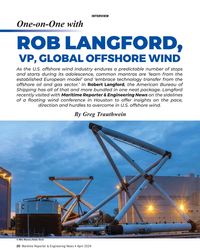 )
April 2024 - Maritime Reporter and Engineering News page: 20
)
April 2024 - Maritime Reporter and Engineering News page: 20INTERVIEW One-on-One with ROB LANGFORD, VP, GLOBAL OFFSHORE WIND As the U.S. offshore wind industry endures a predictable number of stops and starts during its adolescence, common mantras are ‘learn from the established European model’ and ‘embrace technology transfer from the offshore oil and gas
-
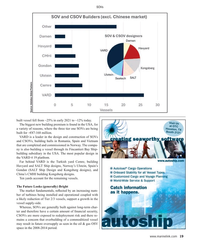 )
April 2024 - Maritime Reporter and Engineering News page: 19
)
April 2024 - Maritime Reporter and Engineering News page: 19SOVs Source: Intelatus Global Partners built vessel fell from ~25% in early 2021 to ~12% today. Visit Us The biggest new building premium is found in the USA, for at OTC Houston, TX a variety of reasons, where the three tier one SOVs are being Booth 2121 built for ~€87-168 million. VARD is a leader in
-
 )
April 2024 - Maritime Reporter and Engineering News page: 18
)
April 2024 - Maritime Reporter and Engineering News page: 18MARKETS & gas activity returns, we anticipate that supply of the vessels The Question of Emissions to offshore wind projects will reduce, driving demand for ad- Given that SOVs and CSOVs operate in a segment target- ditional CSOVs. ing reduced emissions, and many operate in the North Eu- Outside of China
-
 )
April 2024 - Maritime Reporter and Engineering News page: 17
)
April 2024 - Maritime Reporter and Engineering News page: 17SOVs China, we do not look at demand for SOVs/CSOVs as having a linear rela- tionship to the number of wind farms or turbines installed. We look to see where a large number of wind turbines are concentrated in relatively close proximity, generally in a very large wind farm or in a project cluster
-
 )
April 2024 - Maritime Reporter and Engineering News page: 16
)
April 2024 - Maritime Reporter and Engineering News page: 16MARKETS SOVs – Analyzing Current, Future Demand Drivers By Philip Lewis, Director of Research, Intelatus © Björn Wylezich/AdobeStock t a high-level, there are three solutions to transferring Lower day rate CTVs are often used for daily transfer of technicians from shore bases to offshore wind farms
-
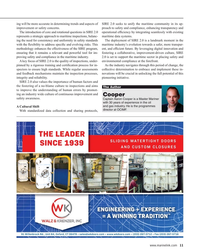 )
April 2024 - Maritime Reporter and Engineering News page: 11
)
April 2024 - Maritime Reporter and Engineering News page: 11ing will be more accurate in determining trends and aspects of SIRE 2.0 seeks to unify the maritime community in its ap- improvement or safety concerns. proach to safety and compliance, enhancing transparency and The introduction of core and rotational questions in SIRE 2.0 operational ef? ciency by
